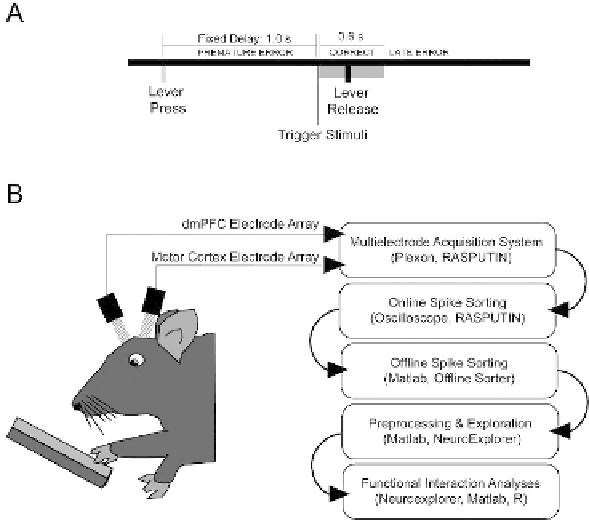Biomedical Engineering Reference
In-Depth Information
Fig. 7.1. Methods for multi-electrode recordings in freely behaving animals. (A)
Sequence of events in delayed-response tasks. Rats were trained in a fixed-delay task,
in which they had to initiate trials by pressing a lever until the end of a fixed (1.0 s) delay
period. Rats had to release the lever within a designated response window to collect a
liquid reward (Correct responses). If the lever was released before the trigger stimulus
(Premature error responses) or after the response window (Late error responses), rats
experienced a timeout period. After rats performed the fixed delay task, animals were
re-trained on a delayed-response with two delays for three days. (B) Methods for col-
lection of multi-electrode data. Briefly, neurophysiological data are collected from the
awake, behaving rats implanted with arrays of electrodes (2 16-wire microwire elec-
trode arrays in dmPFC and motor cortex) during performance of a delayed response
task. Data are streamed to a computer, sorted online using an oscilloscope, cleaned
offline using principal component analysis, loaded into MATLAB and R for subsequent
multivariate analyses.
such data as well as the response properties of single neurons in
these areas are described elsewhere in detail
(14, 20, 21)
. Briefly,
electrical signals from each electrode in dmPFC and motor cortex
are amplified, analog filtered, and streamed to a computer using a
Multi-channel Acquisition Processor (MAP; Plexon, Dallas, TX).
Putative single neuronal units were identified online using an
oscilloscope and audio monitor. Cable noise and behavioral arti-
fact is then cleaned using principal component projections of
potential single units in Plexon's Offline Sorter. Peristimulus Peri-
stimulus arrays of activity around behavioral events of interest are
then constructed and explored using NeuroExplorer (Nex Tech-
nologies; Littleton, MA). All further analyses are performed using
custom-written scripts for MATLAB (The Mathworks, Natick,
MA) (
Fig. 7.1B)
.

